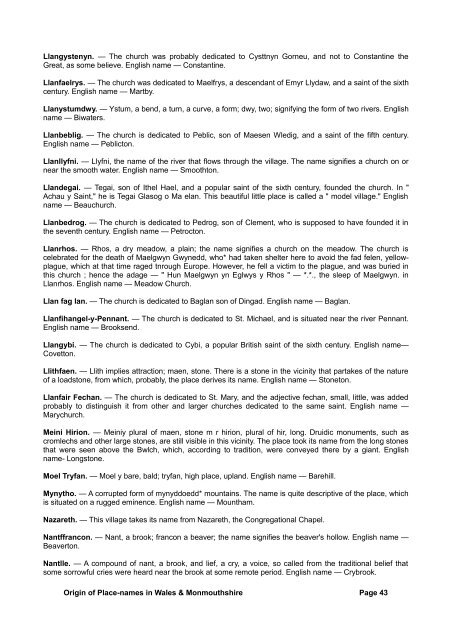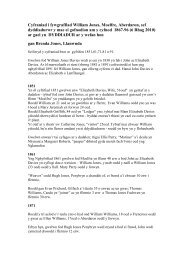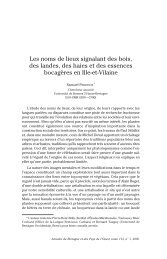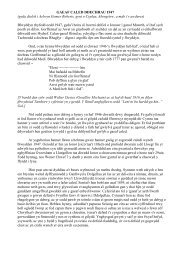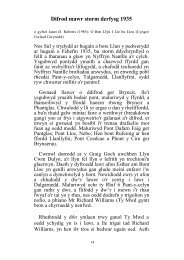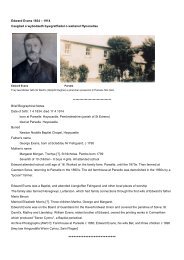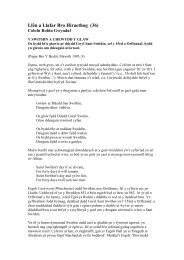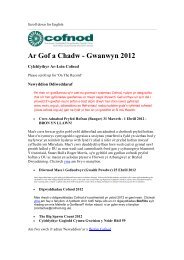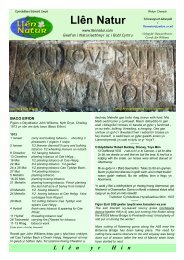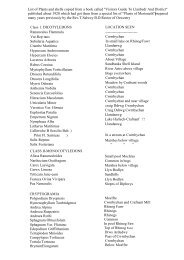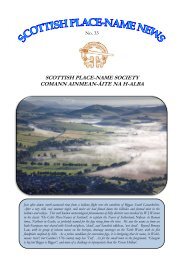Llangystenyn. — The church was probably dedicated to Cysttnyn Gorneu, <strong>and</strong> not to Constant<strong>in</strong>e <strong>the</strong>Great, as some believe. English name — Constant<strong>in</strong>e.Llanfaelrys. — The church was dedicated to Maelfrys, a descendant <strong>of</strong> Emyr Llydaw, <strong>and</strong> a sa<strong>in</strong>t <strong>of</strong> <strong>the</strong> sixthcentury. English name — Martby.Llanystumdwy. — Ystum, a bend, a turn, a curve, a form; dwy, two; signify<strong>in</strong>g <strong>the</strong> form <strong>of</strong> two rivers. Englishname — Biwaters.Llanbeblig. — The church is dedicated to Peblic, son <strong>of</strong> Maesen Wledig, <strong>and</strong> a sa<strong>in</strong>t <strong>of</strong> <strong>the</strong> fifth century.English name — Peblicton.Llanllyfni. — Llyfni, <strong>the</strong> name <strong>of</strong> <strong>the</strong> river that flows through <strong>the</strong> village. The name signifies a church on ornear <strong>the</strong> smooth water. English name — Smoothton.Ll<strong>and</strong>egai. — Tegai, son <strong>of</strong> I<strong>the</strong>l Hael, <strong>and</strong> a popular sa<strong>in</strong>t <strong>of</strong> <strong>the</strong> sixth century, founded <strong>the</strong> church. In "Achau y Sa<strong>in</strong>t," he is Tegai Glasog o Ma elan. This beautiful little <strong>place</strong> is called a " model village." Englishname — Beauchurch.Llanbedrog. — The church is dedicated to Pedrog, son <strong>of</strong> Clement, who is supposed to have founded it <strong>in</strong><strong>the</strong> seventh century. English name — Petrocton.Llanrhos. — Rhos, a dry meadow, a pla<strong>in</strong>; <strong>the</strong> name signifies a church on <strong>the</strong> meadow. The church iscelebrated for <strong>the</strong> death <strong>of</strong> Maelgwyn Gwynedd, who* had taken shelter here to avoid <strong>the</strong> fad felen, yellowplague,which at that time raged tnrough Europe. However, he fell a victim to <strong>the</strong> plague, <strong>and</strong> was buried <strong>in</strong>this church ; hence <strong>the</strong> adage — " Hun Maelgwyn yn Eglwys y Rhos " — *.*., <strong>the</strong> sleep <strong>of</strong> Maelgwyn. <strong>in</strong>Llanrhos. English name — Meadow Church.Llan fag lan. — The church is dedicated to Baglan son <strong>of</strong> D<strong>in</strong>gad. English name — Baglan.Llanfihangel-y-Pennant. — The church is dedicated to St. Michael, <strong>and</strong> is situated near <strong>the</strong> river Pennant.English name — Brooksend.Llangybi. — The church is dedicated to Cybi, a popular British sa<strong>in</strong>t <strong>of</strong> <strong>the</strong> sixth century. English name—Covetton.Llithfaen. — Llith implies attraction; maen, stone. There is a stone <strong>in</strong> <strong>the</strong> vic<strong>in</strong>ity that partakes <strong>of</strong> <strong>the</strong> nature<strong>of</strong> a loadstone, from which, probably, <strong>the</strong> <strong>place</strong> derives its name. English name — Stoneton.Llanfair Fechan. — The church is dedicated to St. Mary, <strong>and</strong> <strong>the</strong> adjective fechan, small, little, was addedprobably to dist<strong>in</strong>guish it from o<strong>the</strong>r <strong>and</strong> larger churches dedicated to <strong>the</strong> same sa<strong>in</strong>t. English name —Marychurch.Me<strong>in</strong>i Hirion. — Me<strong>in</strong>iy plural <strong>of</strong> maen, stone m r hirion, plural <strong>of</strong> hir, long. Druidic monuments, such ascromlechs <strong>and</strong> o<strong>the</strong>r large stones, are still visible <strong>in</strong> this vic<strong>in</strong>ity. The <strong>place</strong> took its name from <strong>the</strong> long stonesthat were seen above <strong>the</strong> Bwlch, which, accord<strong>in</strong>g to tradition, were conveyed <strong>the</strong>re by a giant. Englishname- Longstone.Moel Tryfan. — Moel y bare, bald; tryfan, high <strong>place</strong>, upl<strong>and</strong>. English name — Barehill.Mynytho. — A corrupted form <strong>of</strong> mynyddoedd* mounta<strong>in</strong>s. The name is quite descriptive <strong>of</strong> <strong>the</strong> <strong>place</strong>, whichis situated on a rugged em<strong>in</strong>ence. English name — Mountham.Nazareth. — This village takes its name from Nazareth, <strong>the</strong> Congregational Chapel.Nantffrancon. — Nant, a brook; francon a beaver; <strong>the</strong> name signifies <strong>the</strong> beaver's hollow. English name —Beaverton.Nantlle. — A compound <strong>of</strong> nant, a brook, <strong>and</strong> lief, a cry, a voice, so called from <strong>the</strong> traditional belief thatsome sorrowful cries were heard near <strong>the</strong> brook at some remote period. English name — Crybrook.Orig<strong>in</strong> <strong>of</strong> Place-<strong>names</strong> <strong>in</strong> Wales & Monmouthshire Page 43
Nefyn. — The church was probably dedicated to Nefyn, daughter <strong>of</strong> Brychari Bryche<strong>in</strong>og, <strong>and</strong> a sa<strong>in</strong>t <strong>of</strong> <strong>the</strong>fifth century; hence <strong>the</strong> name <strong>of</strong> <strong>the</strong> <strong>place</strong>. English name — Nev<strong>in</strong>.Portmadoc. — In 1813 Mr. Maddock, Tan-yr-Allt, made an embankment to save <strong>the</strong> site <strong>of</strong> <strong>the</strong> present townfrom <strong>the</strong> <strong>in</strong>cursions <strong>of</strong> <strong>the</strong> sea; <strong>and</strong> <strong>in</strong> 1821 he obta<strong>in</strong>ed an Act <strong>of</strong> Parliament for open<strong>in</strong>g a port <strong>in</strong> <strong>the</strong> <strong>place</strong>,so he is naturally called <strong>the</strong> founder <strong>of</strong> <strong>the</strong> town, <strong>and</strong> his name was deservedly bestowed upon it.Pontnewydd. — Pont, bridge; newydd, new; so called from a certa<strong>in</strong> bridge that was built over <strong>the</strong> riverGwyrfai. English name — Newbridge.Pwllheli. — Pwll, pool; heli, salt water; <strong>the</strong> seaport is situated on <strong>the</strong> edge <strong>of</strong> Cardigan Bay. The Myvyrian "derives heli from Heli, <strong>the</strong> son <strong>of</strong> Glanog. English name — Saltpool.Portd<strong>in</strong>orwig. — D<strong>in</strong>, a hill fort; or-gor, border; wig-gwig, wood, forest; signify<strong>in</strong>g a castle near a wood. TheRev. Isaac Taylor derives it thus: Port Dyn Norwig, <strong>the</strong> "Port <strong>of</strong> <strong>the</strong> Norway men," found<strong>in</strong>g his reasons upon<strong>the</strong> probability that <strong>the</strong> Normans frequently visited that haven. His derivation, <strong>in</strong> our op<strong>in</strong>ion, is ra<strong>the</strong>r farfetched<strong>and</strong> mislead<strong>in</strong>g. English name — Castleport.Penygroes. — So called after an <strong>in</strong>significant cottage <strong>of</strong> <strong>the</strong> name, which stood near a crossway. Englishname — Crossend.Penmaenmawr. — Pen, head; maen, stone, rock; mawr, great. The prefix pen is frequently found <strong>in</strong> <strong>the</strong><strong>names</strong> <strong>of</strong> mounta<strong>in</strong>s, such as Ben Nevis, Appenn<strong>in</strong>es, Pennignant ; La Penne, Penard, &c. Penmaenmawr isa huge mounta<strong>in</strong>, 1545 feet perpendicular from its base, it be<strong>in</strong>g <strong>the</strong> term<strong>in</strong>at<strong>in</strong>g po<strong>in</strong>t <strong>of</strong> <strong>the</strong> Snowdonianrange <strong>of</strong> mounta<strong>in</strong>s. The beautiful water<strong>in</strong>g-<strong>place</strong>, which shelters at its base, takes its name from it. Englishname — Stonehill.Penmachno. — Machno, a mutation <strong>of</strong> Machnawf; mach-moch, ready, quick, swift; nawf, swim. " Moch dysgnawf mab hwyad " — i.e. <strong>the</strong> young <strong>of</strong> <strong>the</strong> duck soon learn to swim. Machno is <strong>the</strong> name <strong>of</strong> <strong>the</strong> river nearwhich <strong>the</strong> village is situated. Some are <strong>of</strong> op<strong>in</strong>ion that <strong>the</strong> name signifies <strong>the</strong> head <strong>of</strong> Machno, a descendant<strong>of</strong> one <strong>of</strong> <strong>the</strong> Irish pr<strong>in</strong>ces that visited <strong>the</strong>se shores about <strong>the</strong> fourth century. The common op<strong>in</strong>ion <strong>of</strong> <strong>the</strong><strong>in</strong>habitants is that machno is a corruption <strong>of</strong> mynachlog, monastery, found<strong>in</strong>g <strong>the</strong>ir reason upon <strong>the</strong>supposition that a monastery stood here <strong>in</strong> time <strong>of</strong> yore. English name — Swifton.Pentir. — The name means headl<strong>and</strong>. Centire has <strong>the</strong> same signification. Pen <strong>in</strong> Gaelic is cen. The <strong>place</strong> isalso called Llangedol, from <strong>the</strong> dedication <strong>of</strong> its church to Cedol, a Welsh sa<strong>in</strong>t. English name — Headl<strong>and</strong>.Penrhyn. — Rhyn means a promontory. Rhe, , run, ra<strong>in</strong>, <strong>and</strong> rhyn, are derivatives <strong>of</strong> <strong>the</strong> Sanscrit W. Rlie &eg, runn<strong>in</strong>g; re<strong>in</strong>deer, <strong>the</strong> runn<strong>in</strong>g deer; <strong>the</strong>, swift. Penrhyn, a po<strong>in</strong>t <strong>of</strong> l<strong>and</strong> that runs <strong>in</strong>to <strong>the</strong> sea. Rh<strong>in</strong>e, arapid river. The Rhyns are numerous <strong>in</strong> our isl<strong>and</strong>. R<strong>in</strong>dow Po<strong>in</strong>t near Wigton; Penrhyn <strong>in</strong> Cornwall; Rhynd <strong>in</strong>Perth; <strong>the</strong> R<strong>in</strong>s <strong>of</strong> Galloway, &c. English name— Capesend.Pen Isa'r Waun. — The name signifies a <strong>place</strong> situated at <strong>the</strong> lower end <strong>of</strong> <strong>the</strong> meadow. English name —Pla<strong>in</strong>send.Penllech. — This name signifies " <strong>the</strong> head <strong>of</strong> <strong>the</strong> rock," from <strong>the</strong> situation <strong>of</strong> <strong>the</strong> <strong>place</strong> at <strong>the</strong> extremity <strong>of</strong>some rocks on <strong>the</strong> coast <strong>of</strong> St. George's Channel. English name — Rockham.Port Penrhyn. — The late Lord Penrhyn made this a shipp<strong>in</strong>g-<strong>place</strong> for <strong>the</strong> slates that were conveyed fromhis quarries <strong>in</strong> <strong>the</strong> Vale <strong>of</strong> Nant Ffrancon; hence <strong>the</strong> name.Pisgah. — So called from Pisgah, <strong>the</strong> Congregational Chapel that was built <strong>in</strong> <strong>the</strong> <strong>place</strong>.Pencarth. — A compound <strong>of</strong> pen, head or end, <strong>and</strong> garth, a promontory, a ridge. English name — Ridgend.Pen Morfa. — The name signifies <strong>the</strong> head or end <strong>of</strong> <strong>the</strong> marsh. The village is situated between some highrocks at <strong>the</strong> end <strong>of</strong> a tract <strong>of</strong> meadows on <strong>the</strong> western bank <strong>of</strong> Traeth Mawr, <strong>the</strong> great beach. It was ancientlycalled Y Wern, <strong>and</strong> supposed to be a seaport before Mr. Maddock raised <strong>the</strong> embankment at Port Madoc.English name — Marshend.Orig<strong>in</strong> <strong>of</strong> Place-<strong>names</strong> <strong>in</strong> Wales & Monmouthshire Page 44
- Page 1 and 2: HANDBOOK OF THE ORIGIN OF PLACE-NAM
- Page 3 and 4: § § § § §The Author begs to st
- Page 5 and 6: pitiful cries of the railway offici
- Page 7 and 8: Bishop Percy says that "in England,
- Page 9 and 10: The city of Chester is still popula
- Page 11 and 12: There's Cumwhitton, Cumwhinton, Cum
- Page 13 and 14: Llwyn in its primary' sense means a
- Page 15 and 16: PLACE-NAMES IN WALES.Wales. — The
- Page 17 and 18: Church are generally dedicated to e
- Page 19 and 20: think he was a contemporary of St.
- Page 21 and 22: Rhosbeirio. — Rhos, a moor, a dry
- Page 23 and 24: of Brecknock," states that this vic
- Page 25 and 26: Cam cnwir ef Cwmdu,Cwm gwyn yw & n
- Page 27 and 28: Penderyn. — A corruption probably
- Page 29 and 30: Ardudwy. — Ar, upon or above; tud
- Page 31 and 32: to mark its pre-eminence over the o
- Page 33 and 34: Some think that eirw is a corruptio
- Page 35 and 36: present form — Caerfyrddin.Abergw
- Page 37 and 38: place of refuge; hence the name. En
- Page 39 and 40: Llansawyl. — The church was dedic
- Page 41 and 42: eject. The village took its name fr
- Page 43 and 44: house, and attempted to kill an inf
- Page 45: Gwydir. — Prima facie one may tak
- Page 49 and 50: DENBIGHSHIRE.Anglicized form of Din
- Page 51 and 52: Llangollen. — From Collen, a sain
- Page 53 and 54: hands into their pockets to pay a c
- Page 55 and 56: Cefn. — The name signifies a ridg
- Page 57 and 58: Maesgarmon. — Named in honour of
- Page 59 and 60: Abertridwr. — Tridwr, three water
- Page 61 and 62: it is said, was originally built by
- Page 63 and 64: Cwmllynfell. — Cwm, a narrow vale
- Page 65 and 66: Gwarycaeau. — Gwdr, the nape of t
- Page 67 and 68: means a cultivated region, a vale,
- Page 69 and 70: Penrhiwfer.- Pen, head, top; rhiw,
- Page 71 and 72: Port Talbot. — So called in 1835
- Page 73 and 74: Trealaw. — This appellation was g
- Page 75 and 76: Aberdyfi. — So called from its si
- Page 77 and 78: Llanddwywe. — From Dwywau, a desc
- Page 79 and 80: Crickhowell and some in the directi
- Page 81 and 82: Griffithstown. — This village was
- Page 83 and 84: and gwy, water. Treiddiod troth tna
- Page 85 and 86: derive Tintern from din, fortified
- Page 87 and 88: Caersws. — It appears that the Ro
- Page 89 and 90: English name — Ervylton.Llanymech
- Page 91 and 92: Angle. — Probably from the angle-
- Page 93 and 94: Gellyswick. — Another hybrid. Gel
- Page 95 and 96: that the two rivers in their flowin
- Page 97 and 98:
ecame the bishop of the see, and wa
- Page 99 and 100:
earth formerly stood on a summit on
- Page 101 and 102:
Pilleth. — A corruption of pwll,
- Page 103 and 104:
Howells, Rev. J., Mountain AshHowel
- Page 105 and 106:
Williams, D., PenywernWilliams, Rev


